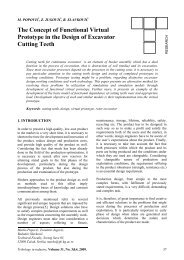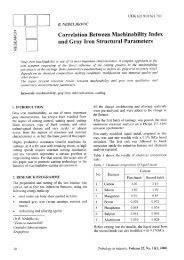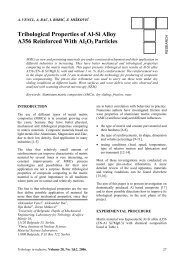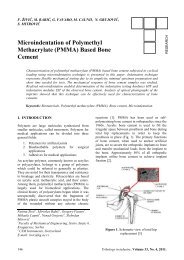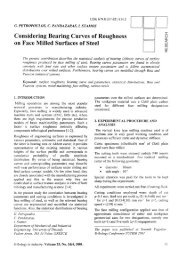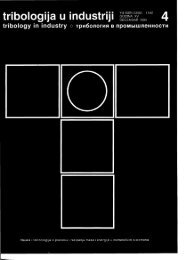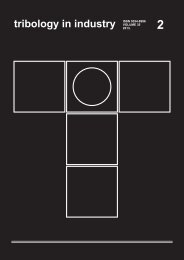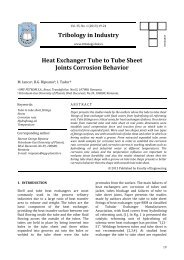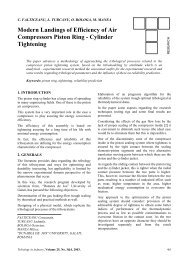A. Lanzutti at al., Tribology in Industry Vol. 35, No. 2 (2013) 113‐122<strong>of</strong> oxide decreased the surface energy inproximity <strong>of</strong> the hertzian contact <strong>of</strong> the twomaterials, reducing the friction coefficient. Whenthe oxide was broken the contact between thetwo materials was between the WC and theNi/Cr slightly oxidized.COF [-]RT test300°C testTime [s]a)COF [-] COF [-]Time [s]a)b)Time [s]COF [-] COF [-]RT test300°C testRT test300°C testTime [s]Time [s]Fig. 8. COF graphs at both room temperature and 300°C for the thermal spray coatings: a) NiCr 80/20, b)Wc Co Cr (18/4), c) NiCr 80/20+ Cr 2 O 3 .b)c)Fig. 9. COF graphs at both room temperature and 300°C for the Ni/SiC composite coatings: a) Roomtemperature test, b) 300 °C.For the WC‐CoCr coating the COF are slightlydifferent and this is caused mainly <strong>by</strong> thenumber <strong>of</strong> third body particles produced duringthe test. Indeed is possible that at hightemperature the amount <strong>of</strong> abrasive particles,that are taking part to the hertzian system, arehigher due to the intense triboxidation thatcause probably a high amount <strong>of</strong> descaled oxide.At the end <strong>of</strong> the test part <strong>of</strong> the particles areevacuated from the wear track reaching a COFvalue comparable with the room temperature test.The COF acquired from the test performed at 300°C is lower compared to the value acquired atroom temperature test. This behaviour is relatedto the change phase <strong>of</strong> ceramic oxide thatdecreased the contact energy and thus the COF.The friction coefficient values are higher at thestart <strong>of</strong> the test because <strong>of</strong> possible partialfragmentation <strong>of</strong> the material caused <strong>by</strong> brittlecontact between the countermaterial and thecoating. This leads to have an high amount <strong>of</strong> thirdbody particles that increase the COF value, at thebeginning, that is decreasing, during the test,because <strong>of</strong> particle’ evacuation form the wear trackcaused <strong>by</strong> the relative motion <strong>of</strong> the two materials.120
A. Lanzutti at al., Tribology in Industry Vol. 35, No. 2 (2013) 113‐122The COF acquired for the Ni/SiC electrodeposits islower compared to the pure Ni electrodeposit. Thiscould be related to both different mechanicalproperties <strong>of</strong> the composite material respect to thepure Ni and possible interactions <strong>of</strong> SiC particleswith countermaterial that could lower the surfaceenergy and interaction <strong>of</strong> the 2 surfaces.At high temperature the COF graphs are verysimilar and this behaviour could be related to thechange <strong>of</strong> contact, compared with roomtemperature test that is between Ni oxide and theWC sphere, instead <strong>of</strong> Ni slightly oxidized and WC.4. CONCLUSIONSIn this work different type <strong>of</strong> coatings have beenanalysed deposited either <strong>by</strong> thermal spraytechniques or <strong>by</strong> electrodeposition. The coatingsdeposited <strong>by</strong> thermal spray are: NiCr (APS), WCCoCr (HVOF) and NiCr+Cr 2 O 3 (APS) . Theelectrodeposits are Ni/SiC coatings with nano‐ ormicro‐sized particles embedded in metal matrix.The analysed coatings showed differentmicrostructure that depends on both depositedmaterial and deposition technique.Regarding the wear properties, the steel substrateshowed the worst wear resistance at both roomtemperature and 300 °C. This behaviour is relatedto the low mechanical properties <strong>of</strong> this steel thatare decreasing as the temperature increases.All the tested metal matrix coatings underwenttriboxidation that was increased at hightemperature test. The triboxidation behaviourdepends on metal oxidation resistance. The ceramiccoating was subjected to an intensive materialdetachment, caused mainly <strong>by</strong> the highinterconnected porosity <strong>of</strong> the thermal sprayedcoating. The detachment increased in function <strong>of</strong>temperature because the ceramic oxide changedphase under the hertzian loads. For all the metalmatrix coatings was present a third body abrasioncaused mainly <strong>by</strong> both oxide descaling and ceramicreinforcement detachment from the metal matrix.Observing the wear rates, the WC CoCr coatingshowed the highest wear resistance at bothroom temperature and 300 °C. This behaviour isrelated to the microstructure <strong>of</strong> the deposit: thereinforcing particles (WC) give high hardnessalso at high temperature and the metal matrix(CoCr) increases the toughness <strong>of</strong> the coatingand acts as binder for the reinforcing particles.The electrodeposits Ni/nSiC showed a wearbehaviour that is comparable with the WC CoCrone. For the nano‐composite electrodeposits thesynergy <strong>of</strong> both grain refinement and nanoparticlesembedding leads to an increase <strong>of</strong>hardness at both room temperature and 300 °C.This effect probably enhances the wearresistance <strong>of</strong> the Ni metal matrix that issubjected to hertzian loads.The COF values are strongly dependent on thematerial analysed but it was observed, forthermal spray coating, similar COF valuesbetween the room temperature test and the 300°C tests. The ceramic coating showed the lowestCOF values at high temperature caused mainly<strong>by</strong> the production <strong>of</strong> brittle CrO 2 phase. Theelectrodeposits showed some differences in theCOF values between the high temperature testsand the room temperature tests caused mainly<strong>by</strong> the change <strong>of</strong> hertzian contact from Nislightly oxidized, at room temperature, to Nistrongly oxidized, at 300 °C. At roomtemperature is visible a different in COF valuebetween pure metal and composite coatings.This effect is related to the different mechanicalproperties <strong>of</strong> the coating and the possibleinteraction <strong>of</strong> reinforcing particles with thecountermaterial in the hertzian contact/motion.REFERENCES[1] N.F. Ak, C. Tekmen, I. Ozdemir, H.S. Soykan, E.Celik: NiCr coatings on stainless steel <strong>by</strong> HVOFtechnique, Surface and coatings technology, Vol.173‐174, pp. 1070‐1073, 2003.[2] B.S. Sidhu, D. Puri, S. Prakash: Mechanical andmetallurgical properties <strong>of</strong> plasma sprayed andlaser remelted Ni‐20Cr and stellite‐6 coatings,Journal <strong>of</strong> Materials Processing Technology, Vol.159, pp. 347‐355, 2005.[3] H. Singh, D. Puri, S. Prakash: Some studies on hotcorrosion performance <strong>of</strong> plasma sprayedcoatings on Fe‐based superalloy, Surface &coatings technology, Vol. 192, pp. 27‐38, 2005.[4] H.S. Ahn, O.K. Kwon: <strong>Tribological</strong> behaviour <strong>of</strong>plasma‐sprayed chromium oxide coating, Wear,Vol. 225‐229, pp. 814‐824, 1999.[5] G. Bolelli, V. Cannillo, L. Lusvaraghi, T.Manfredini: Wear behaviour <strong>of</strong> thermally sprayed121



